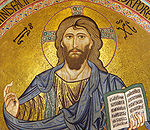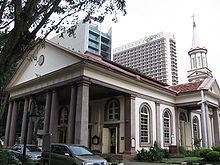- Christianity in Singapore
-
Christianity by Country
North AmericaSouth AmericaOceaniaChristians in Singapore constitute approximately 17.5% of the population.[citation needed] In the 2000 Census, 4.8% of residents aged 15 years and older, identified as Catholic and 9.8% as 'Other Christians'.[1]
Contents
History
Christianity first arrived on Singapore's shores soon after the founding of modern Singapore in 1819. Within half a year, the first Protestant missionary arrived to set up a local ministry.[citation needed] The first Roman Catholic priest came in December 1821 to look into the feasibility of opening a missionary station, and celebrated the first Mass.
The colonial administration adopted an official policy of neutrality and non-interference regarding religion. Missionaries established churches and Christian ministries on the island. They also set up welfare organisations and many missionary schools which are well regarded for their high quality education today.[citation needed]
Local-born church leaders gradually took over the running of their ministries. Theological colleges were established to produce the next generation of leaders, and more churches and Christian organisations were set up, resulting in an increase in the proportion of Christians in Singapore today. The percentage of Christians among Singaporeans increased from 12.7% in 1990 to 14.6% in 2000.[2] whilst the latest census as of 2010 has showed the Christian population increase from 14.6 % to 17.5%. [3]
Denominations
Catholic (Roman)
Main article: Roman Catholicism in SingaporeThe Roman Catholic population in Singapore generally consists of Eurasians, Chinese (including Peranakans), Filipinos and Indians. The majority of Roman Catholics, notably those who are older, are noted for their preference of English customs and masses conducted in Latin. Younger Roman Catholics tend to prefer less formal forms of worship similar to those practised by Protestants,[citation needed] and also prefer masses in the vernacular. There is, however, a growing number of young people[who?] interested in more traditional forms of worship, and a movement[who?] to restore the ancient Gregorian Chant, deeper reverence in ritual actions, and the Latin Mass is gaining ground[citation needed]. There are 31 Roman Catholic parishes in Singapore, each administering to a particular district in Singapore.
The Cathedral of the Good Shepherd is the oldest Roman Catholic church in Singapore.
Singapore has a Roman Catholic Archdiocese headed by His Grace Archbishop Nicholas Chia who presides at the Cathedral of the Good Shepherd. The Holy Mass in Singapore is celebrated in numerous vernacular tongues, including English, Mandarin, Hokkien, Teochew, Tamil, Malayalam, Tagalog and Korean (at the Cathedral of the Good Shepherd). Malay is seldom used.
Peranakan Roman Catholics are generally concentrated in the Church of the Holy Family in Katong; whilst St Joseph's Church along Victoria street is a cultural base for Portuguese Eurasians. Roman Catholic parishes in the 18th to early 19th centuries were initially setup along racial and cultural lines by various Roman Catholic missionary groups from Europe.
Various Roman Catholic parishes in Singapore are actively involved in social services such as welfare homes, the opening of soup kitchens as well as missionary trips to place like Indonesia and the Philippines. There is also the Catholic Medical Guild, and other Roman Catholic lobby groups that are based in the Church of St Peter & Paul parish grounds. They are also currently supporting the creation of Small Christian Communities (SCC) in order to organise and gather the Roman Catholic communities within their neighbourhoods.
Eastern Catholics
A fledgling Greek-Catholic community, dependent on the Ukrainian Greek-Catholic bishop of Melbourne, is also growing and meets in private.
Eastern and Oriental Orthodox
The Armenian Church is the oldest Christian church in Singapore.
Other Christian churches in Singapore include the old Armenian Church which has a church building but has had no resident clergy for many decades, the Coptic Orthodox Church which meets in the Armenian Church, and the Syrian Orthodox Church; the latter two churches generally minister to the Coptic and Indian communities respectively. There is also a small but growing Eastern Orthodox congregation made up of ethnic Armenians, Egyptians, Greeks, Indians and Russians, constituting a small minority in the local Christian population.
Protestant
The majority of Christian churches are under the umbrella of the National Council of Churches of Singapore.[4] Most belong to Protestant traditions which consist of an array of denominations. The more prominent ones include the Anglican, Baptist, Plymouth Brethren, Lutheran, Methodist and Presbyterian churches. In recent years, independent non-denominational megachurches have sprung up and been successful in reaching out to new members.
Anglicanism is represented in Singapore by the Church of the Province of South East Asia, of which the Diocese of Singapore is responsible for 26 parishes within Singapore as well as six deaneries in other Southeast Asian countries.
Although the churches seem divided along denomination lines, many Christian ministries and congregations often come together and co-ordinate activities and good works for both the Christian community and society at large. In addition, Singapore is considered a key base for missionary and humanitarian activities in the Asia-Pacific region and beyond.
Beyond the churches, there are many Christian organisations engaging in activities such as fund raising, healthcare for the needy, establishing homes for the elderly, providing family services and youth development. These organisations include the Salvation Army, Fei Yue Family Centres, Teen Challenge and various community hospitals. The Christian community also comes together for fund-raising events like the LoveSingapore movement which organises walkathons and prayer sessions for those in need.
Megachurches
Recently, megachurches such as City Harvest Church, Faith Community Baptist Church and New Creation Church have been very successful in attracting large numbers of youths and working adults to convert to their versions of Christianity. These churches usually have services in which songs are performed in contemporary style, which are seen as trendy by many youths. Nevertheless, they are not without controversy and some older Christians consider the practices of such churches to be contrary to the traditions of Christianity.[citation needed]
Inter-faith
Singapore is a society of diverse religious traditions. The Declaration of Religious Harmony, which was published in 2003, is a seminal document, which the National Council of Churches of Singapore supported and helped create. On September 3, 2008, the sociologist and Pentecostal pastor, Mathew Mathews, who was named a visiting fellow of the Sociology department at the National University of Singapore, interviewed 183 Singaporean clergy. From these interviews he formed the opinion that the Christian clergy in many parts of Singapore were wary of inter-faith dialogue. He claimed that nearly 50% of clergy believe that inter-faith dialogue compromises their own religious convictions. He presented his paper to the Institute of Public Studies (Singapore) in a forum they organised on September 2, 2008.[5][6]
Schools
Anglican schools
- Anglican High School
- Christ Church Secondary School
- Saint Andrew's Junior School
- Saint Andrew's Secondary School
- Saint Andrew's Junior College
- Saint Hilda's Primary School
- Saint Hilda's Secondary School
- Saint Margaret's Primary School
- Saint Margaret's Secondary School
Methodist schools
- Anglo-Chinese School (Junior)
- Anglo-Chinese School (Primary)
- Anglo-Chinese School (Barker Road)
- Anglo-Chinese School (Independent)
- Anglo-Chinese Junior College
- Anglo-Chinese School (International)
- Fairfield Methodist Primary School
- Fairfield Methodist Secondary School
- Geylang Methodist Primary School
- Geylang Methodist Secondary School
- Methodist Girls' School (Primary)
- Methodist Girls' School (Secondary)
- Paya Lebar Methodist Girls' School (Primary)
- Paya Lebar Methodist Girls' School (Secondary)
Presbyterian schools
- Kuo Chuan Presbyterian Primary School
- Kuo Chuan Presbyterian Secondary School
- Pei Hwa Presbyterian Primary School
- Presbyterian High School
Roman Catholic schools
- Assumption English School
- Assumption Vocational Institute
- Canossa Convent Primary School
- Canossian Convent Kindergarten
- Canossian School For The Hearing-Impaired
- Catholic High School
- Catholic Junior College
- CHIJ Katong (Primary)
- CHIJ Katong Convent
- CHIJ Kellock Primary
- CHIJ Our Lady of Good Counsel
- CHIJ Our Lady Queen of Peace
- CHIJ Our Lady of the Nativity
- CHIJ Primary (Toa Payoh)
- CHIJ Saint Nicholas Girls' School
- CHIJ Saint Joseph's Convent
- CHIJ Saint Theresa's Convent
- CHIJ Secondary School (Toa Payoh)
- De La Salle School
- Good Shepherd Kindergarten
- Hai Sing Catholic School
- Holy Innocents' High School
- Holy Innocents' Primary School
- Magdalene's Kindergarten
- Maris Stella Kindergarten
- Maris Stella High School
- Marymount Convent School
- Montfort Junior School
- Montfort Secondary School
- Nazareth Centre Kindergarten
- St Anthony's Canossian Primary School
- St Anthony's Canossian Secondary School
- St Anthony's Primary School
- St Gabriel's Primary School
- St Gabriel's Secondary School
- Saint Joseph's Institution (International)
- Saint Joseph's Institution
- Saint Joseph's Institution Junior
- Saint Patrick's School
See also
References
- ^ Dept. of Statistics, Ministry of Trade and Industry, Singapore (October 2001). Census of Population 2000: Statistical Release 2: Education, Language and Religion. Singapore: The Dept.. Table 39 ("Resident Population Aged 15 Years and Over by Religion, Ethnic Group and Sex"). ISBN 981-04-4459-1. http://www.singstat.gov.sg/pubn/popn/c2000sr2/t38-45.pdf..
- ^ Sng, Bobby E.K. (2003). In His Good Time: The Story of the Church in Singapore 1819–2002 (3rd ed. ed.). Singapore: Bible Society of Singapore. p. 337. ISBN 981-220-286-2.
- ^ "Better-educated S'pore residents look to religion". Jan 13, 2011. http://news.asiaone.com/News/AsiaOne%2BNews/Singapore/Story/A1Story20110113-257921.html. Retrieved Feb 26, 2011.
- ^ "National Council of Churches Singapore Website". National Council of Churches Singapore Website. http://www.nccs.org.sg/NCCS/Members.html.
- ^ Li, Xueying. "Clergy 'Wary Of Inter-Faith Talks'", The Straits Times, 2008-09-23
- ^ http://newshub.nus.edu.sg/news/0809/pdf/CLERGY-st-3Sept-pB5.pdf
External links
- Antioch.com.sg: Partial directory of non-Roman Catholic churches in Singapore
- Singapore Christian Web
- Veritas (official website of the Roman Catholic Archdiocese of Singapore): Singapore Catholic church directory
Christianity in Asia Sovereign
states- Afghanistan
- Armenia
- Azerbaijan
- Bahrain
- Bangladesh
- Bhutan
- Brunei
- Burma (Myanmar)
- Cambodia
- People's Republic of China
- Cyprus
- East Timor (Timor-Leste)
- Egypt
- Georgia
- India
- Indonesia
- Iran
- Iraq
- Israel
- Japan
- Jordan
- Kazakhstan
- North Korea
- South Korea
- Kuwait
- Kyrgyzstan
- Laos
- Lebanon
- Malaysia
- Maldives
- Mongolia
- Nepal
- Oman
- Pakistan
- Philippines
- Qatar
- Russia
- Saudi Arabia
- Singapore
- Sri Lanka
- Syria
- Tajikistan
- Thailand
- Turkey
- Turkmenistan
- United Arab Emirates
- Uzbekistan
- Vietnam
- Yemen
States with limited
recognition- Abkhazia
- Nagorno-Karabakh
- Northern Cyprus
- Palestine
- Republic of China (Taiwan)
- South Ossetia
Dependencies and
other territories- Christmas Island
- Cocos (Keeling) Islands
- Hong Kong
- Macau
Categories:
Wikimedia Foundation. 2010.



